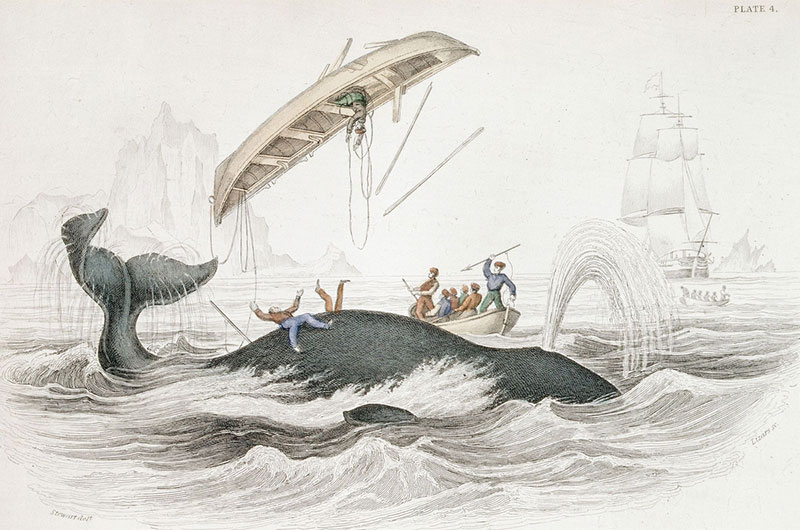by Amy Jenness author of On This Day in Nantucket History
On June 1, 1796, the British brig Swallow received a “Letter of Marque,” which gave it the authority to capture French ships. The Letter of Marque and Reprisal is a government license authorizing privateers to attack enemy vessels (Britain and France were at war at the time) and bring them before admiralty courts for condemnation and sale. Six years later, in December of 1803, the Swallow captured the French whale ship Hero off the coast of Portugal, and its captain, Stephen Rawson, and its first mate, William Morris, hailed from Nantucket.
While the American whaling industry exploded in the post American Revolution years, both the French and English hoped to also capitalize on the profits of a whale hunt. The two governments courted American whaleship owners to establish European whaling ports and also outfitted whaling fleets of their own. But neither England nor France was ever able to dominate the industry the way Americans did. Yet, it was not unusual to find Nantucket mariners, more in tune with life on a ship than to governmental borders, on their ships.
The whaling industry grew rapidly after the first American whaleship rounded Cape Horn in 1791 and killed whales in the Pacific Ocean. Within 10 years, hundreds of whaleships from all over the world were hunting in the Pacific Ocean and Arctic Sea waters. And, after its capture by the British, the whaleship Hero would be one of them.
Late in the year of 1802, the Hero, an American cargo ship, had landed in Le Havre, France just as Napoleon Bonaparte was visiting. The emperor bought the ship and refitted it as a French whaleship. In early 1803, the Hero went south on a whaling voyage with a mixed crew of Americans, Frenchmen, and Englishmen.
The British took Hero back to Britain and First Mate Morris testified before the British Admiralty Court. On June 1, 1804, records state that twenty-fiveyear- old Morris “answers that He was born and has always resided, save when subject at sea, and now lives with his wife and family…at Nantucket.” In his testimony, Morris said he was not an owner of the Hero but had the usual 1/25 interest in the profits from the voyage.
After extensive testimony, the court claimed the Hero a lawful prize of war and condemned it. In September 1805, it was sold and renamed the Atlantic. By 1806, the Atlantic was a British whale ship captained by William Swain of Nantucket, who would have one of the longest careers in the British whale fishery.
THE MILFORD HAVEN EXPERIMENT
The American Revolution was a time of hardship for Nantucket. The independent and tiny island far out to sea made both sides wary. England and the patriots banned Nantucket ships from fishing and established trade embargos on the island. Adding to the tension was the island’s dynamic mixture of staunchly pacifist Quakers, who refused to take a side in the conflict, and loyalists who sided with England. By the end of the American Revolution the people of Nantucket were starving and without supplies or heating fuel. When the war ended, Nantucketers went right back to whaling and soon the island bustled again with maritime and whaling-related trade. But England, by far the biggest consumer of spermaceti whale oil (the most lucrative whale commodity), levied a heavy tax on imported whale oil products. In 1783, when they grew tired of the hardships imposed upon their business, prominent Nantucket whaleship owners began to leave the island. Timothy Folger and Samuel Starbuck, Sr relocated to Nova Scotia, an English-owned province and therefore free of the import tax. William Rotch and his sons moved their operations first to Dunkirk, France and later to London, England.
In 1791, a British entrepreneur got government funding to create a new town on the Wales coast called Milford Haven, which would become a whaling port. The government offered Nantucket families political and financial incentives to help it establish whaling there. Among them were Folger, Starbuck, and Rotch who all agreed to move their whaling operations to Milford Haven.
The Nantucket settlers gave the English a list of requirements in exchange for their participation and among them were: a request for a Quaker Meeting House, specific plans for docks and wharves, and a declaration that they would not farm the land (they would be solely focused on whaling). The town was supposed to have been built by the time they arrived in 1792, but it was not. The buildings that grew up in those first years strongly resemble the architecture of Nantucket’s simple, shingle-clad houses. and street names contain island family names like Starbuck and Bunker.
For a time Milford Haven developed into an international whaling hub. Ships came or left for whaling grounds around the world. The Milford Havenwhaling ships were provisioned in Nantucket and New Bedford because it was cheaper. Although Milford Haven whaleships did hunt in the southern fishery, the transplanted Nantucketers profited considerably from their toehold in England. Folger traded foods like corn, wheat, rye, and barley. Rotch traded in American whale oil and Nantucket-made spermaceti candles.
The Milford Haven whaling experience was short lived. The town created to turn Britain into a whaling powerhouse actually became an outpost for American mariners, particularly Nantucket whalers. By 1800 Milford Haven was better known to England as a Royal Navy dockyard than as a whaling center, and today it is England’s fourth largest commercial port. By 1814 the whaling at Milford Haven was finished, in part due to financial setbacks in the industry and to the British government’s preference for supporting English whaling, which was based in London.

